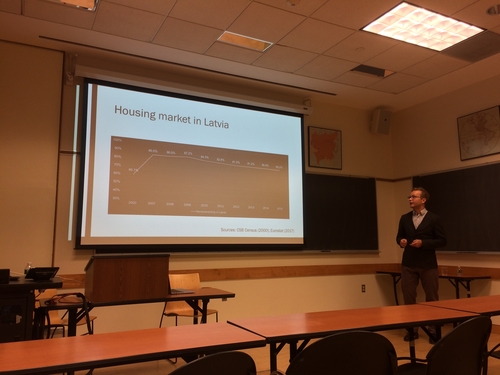
Latvia’s economic recovery has been touted as one of Europe’s success stories since the financial crisis. Having shrunk more than 14 percent in 2009 – three times more than the EU average that dismal year – the Baltic country’s GDP was going strong again by 2011, growing 6 percent.
But social science researcher Andris Saulītis has his doubts. “Is this a success story at just the macro-level, or also at the micro-level?” he asked the audience assembled at his December 7 presentation capping off his semester as Juris Padegs Visiting Assistant in Research of Baltic Studies at Yale.
After a decade-long spike in home ownership, according to Saulītis, Latvians were dangerously leveraged with mortgages on the eve of the crisis (as was the case in the United States). And the price is still being paid – with interest.
On average, Latvians remain among the most indebted citizens in the EU. And bankruptcies declared in Latvia have been on the rise since 2010.
These are among the trends that caught Saulītis’ eye when looking to see how the recovery has taken place on an individual level. And they have formed the basis of the PhD project he has undertaken at the European University Institute in Florence. His research aims to shed light on the social ramifications of the financial crisis by analyzing how Latvians have coped with this over-indebtedness.
One way to cope, of course, would simply be to do away with the debt. Debt relief, Saulītis noted, has a long-established precedence – and pardoning was once even a joyous event that celebrated the mercy of the rich and the respite of the poor. But now things are different. Debt relief has become highly bureaucratized and stigmatized procedure, something that one would much prefer to keep private.
Still, instead of scrounging to pay everything back or simply running away from their obligations, some Latvians have quietly turned towards bankruptcy procedures. And during the presentation, Saulītis took the audience through the procedure, which involves a third of one’s income going towards the debt for as long as the process lasts. For someone in relatively good shape this could mean months. In more troubled cases, this could take a number of years.
That bankruptcies have lately become more frequent in Latvia is not necessarily troubling. In 2010, the country put into place what is hailed as “one of the most liberal insolvency laws in the European Union,” one that more actively seeks to give debtors a second chance. More than three-fourths of those who file for bankruptcy successfully complete the process.
But all is not so easily written-off and forgotten. The average applicant recovers only 12 percent of their total debt amount. And only half of the entrepreneurs who undertook the process resumed business activity since making it through. Likely to be the most lingering consequence, though, is the shame experienced by those who have declared bankruptcy, often seen as financial failures and downwardly mobile.
For his gathering of statistics, Saulītis has had at his disposal a database that many researchers would consider a dream. Applicants for bankruptcy are listed on an online register alongside revealing demographic and economic information. But for those listed, concerned about their reputation, this insolvency register can seem more like a nightmare. It is “something that needs to be changed,” regretted Saulītis.
He hopes to better understand such dynamics of shame once he begins personally interviewing those who have gone through the bankruptcy procedure. But broaching such topics – let alone getting in touch with the subjects to do so – is never easy. Saulītis said he had already reached out to the 31 Latvians who have filed for bankruptcy in the United Kingdom. One responded, wanting to know how Saulītis had found his address.
Written by Jeff Michels, a graduate student in the European Studies program.

